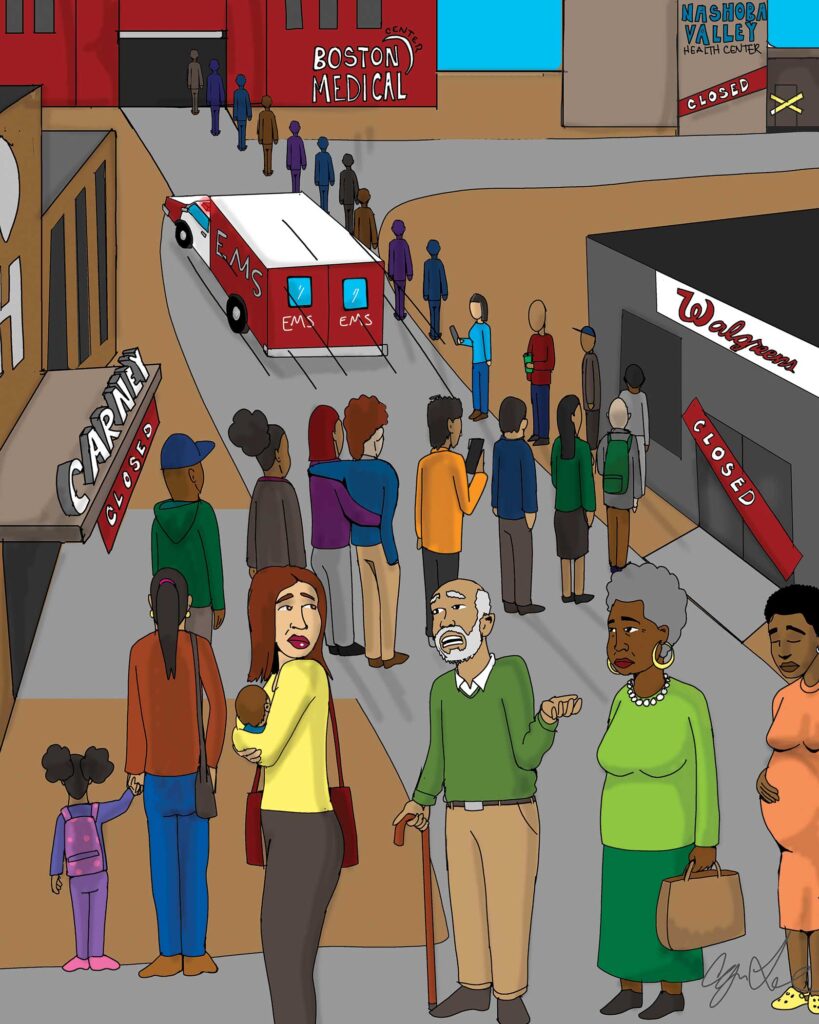
The closure of Carney Hospital leaves significant gaps in the health services available in Dorchester, Boston’s largest neighborhood and one where a majority of residents are people of color, creating an emergency and urgent care desert in the neighborhood.
As displaced patients look for health care, many local community health centers are seeing a surge in new patients.
There has been no additional investment in community health centers that would allow them to scale up to serve the displaced primary care or urgent care patients who otherwise would have gone to Carney.
The city’s health officials need to work together with their counterparts in state government and the private sector to come up with solutions to fill the resulting gaps in emergency and urgent care, hospital beds and medical specialists.
A public-private collaboration, or maybe more than one, is in order, along with some creative problem-solving.
As Congresswoman Ayanna Pressley, whose district includes Dorchester, has pointed out, Carney’s emergency room was an efficient provider of care for patients who had suffered an accident or contracted an ailment not readily identifiable by a parent or someone without medical training. Rarely was the waiting room crowded. You could be seen, treated and released, typically, within a coupe hours. That convenient access to emergency care is gone.
Boston Medical Center is relatively close, but its emergency room is already overburdened. BMC has a well-deserved reputation for quality care for serious trauma. The downside of that attribute is, when standard triage evaluation is applied, the kid who has had a persistent fever and cough long enough to worry parents usually has to wait. And wait some more. A whole day can pass before a harried emergency room doctor has a chance to evaluate the child’s symptoms, make a diagnosis and prescribe treatment. And if you do not have a car, like many people in the affected population, the trip on public transportation requires multiple transfers and could take a couple of hours each way.
Beth Israel Deaconess Milton Hospital could be an option. It’s only two miles from Carney. But the Milton Hospital’s website has already posted an alert: “Due to an increased demand in EMERGENCY SERVICES, wait times may be longer than usual.” Besides, isn’t kind of galling for a resident of Boston, with its wealth of hospitals, to have to leave the city for treatment in a suburb?
Private urgent care centers do not provide the full range of emergency room services but could fill some of the gap that results from Carney’s demise. Those centers, however, tend to prefer suburban locations, presumably because more residents there have private insurance, which reimburse at higher rates than MassHealth for low-income people or Medicare for seniors and disabled people.
Perhaps Mayor Michelle Wu and state health officials can devise a set of financial incentives to lure an urgent care center or two to open in high-needs Dorchester. Some suburban CVS outlets have urgent care centers inside their doors. Within a short drive from Carney, the drugstore giant already operate three locations on the arterial road known variously as Morton Street, Gallivan Boulevard and Morrissey Boulevard. Another CVS is even closer, just blocks down Dorchester Avenue in Lower Mills.
The in-patient beds at Carney were underutilized in recent years. But the loss of its 70 psychiatric beds represents a serious loss. Those services are frequently in short supply. It’s a vexing problem for a parent or spouse to find such a bed when a mental health emergency arises at unpredictable times. Guardians often need to find serial placements to find the right one that suits their loved one and applies the right approach to stabilize a patient and begin the process of healing. Who will help Dorchester residents find in-patient beds now that the convenient, accessible ones are Carney are unavailable?
The Seton medical building attached to Carney had been home to a variety of medical specialists. Nurse practitioners at Daniel Driscoll-Neponset Health Center, nearby off Gallivan Boulevard, have routinely referred their patients to Carney-affiliated practitioners for specialized diagnosis and treatment.
Bankrupt Steward Health Care has moved to sell its doctors group in addition to its hospitals in Massachusetts. But would affiliated physicians keep their offices open next to a vacant hospital? Why would they? Is that even practical, given that the hallways of the Seton Building and the hospital are interconnected? In recent years, some specialists have already abandoned their Dorchester office and moved to their other one in the suburbs. Some retreated to the doctors building at Beth Israel Deaconess Milton Hospital.
The loss of one facility at Carney could actually provide an opportunity. A family-run pharmacy — a rarity in the chain-dominated market — operated off the hospital’s lobby and may be looking to relocate. Might it find a new location in an underserved area of Dorchester — 40% of the city’s land mass — that’s a pharmacy desert? Roxbury, too, certainly could use another pharmacy, after the closures not long ago of a Walgreens and a CVS. Might the city lure the former Carney pharmacy, with favorable lease terms in a city-owned building, to locate in an area that needs one?
The closure of Carney means the medical professionals who toiled there have lost their jobs. Who’s helping them find new jobs in the city? Let’s hope the high demand for health care, fueled by aging Baby Boomers, helps them land on their feet.
In particular, here’s a wish for a comparable administrative career future for Stan McLaren, Carney’s last CEO. He arrived there in 2021 after a well-regarded tenure leading Harvard Street Neighborhood Health Center in another part of Dorchester.
“I did not come here for the hospital to close,” McLaren told the Banner last summer. Carney’s closure is not his fault, but the fault of his corporate bosses at Steward Health Care, a for-profit entity whose fiscal management was short-sighted and too driven by the bottom line. Dorchester residents are now paying for their imprudent myopia.







